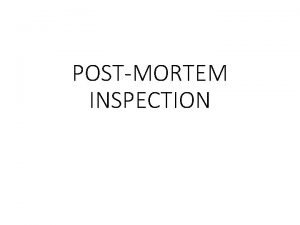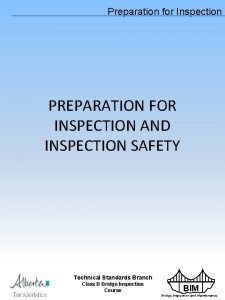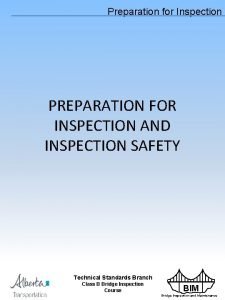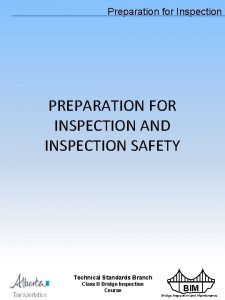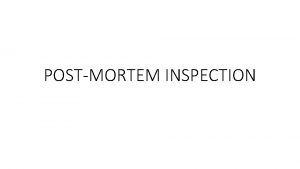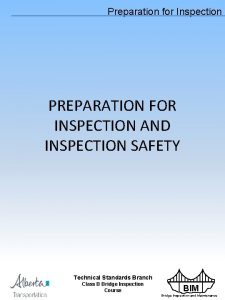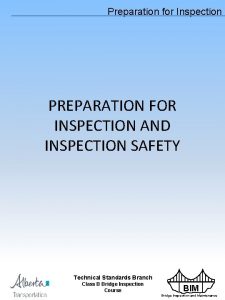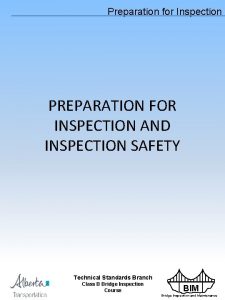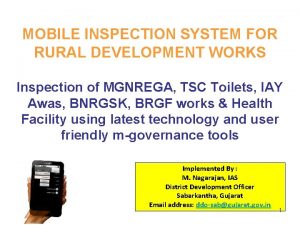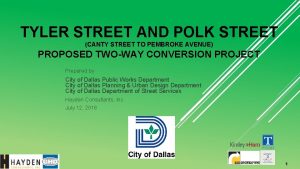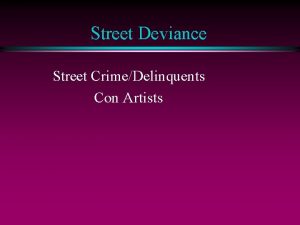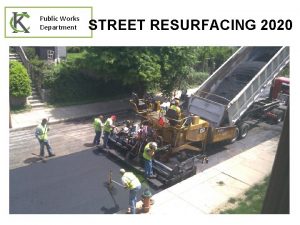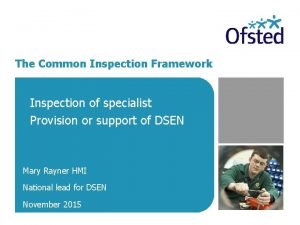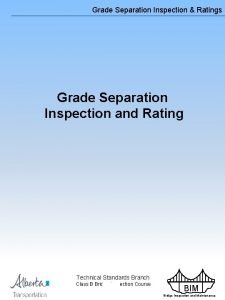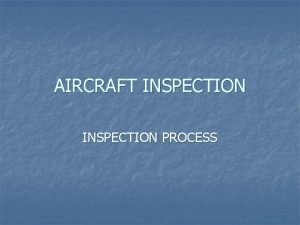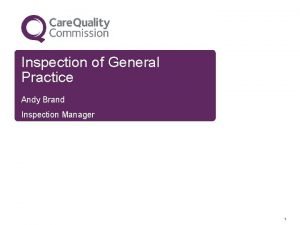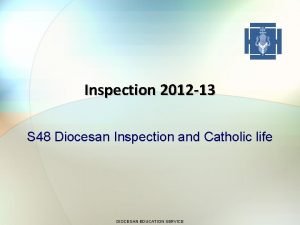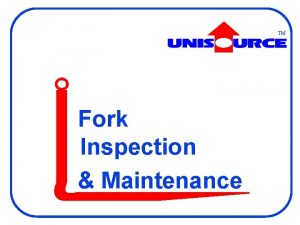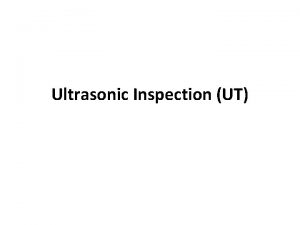Street Works Inspection of Street works Sites For






















































- Slides: 54

Street Works Inspection of Street works Sites For those involved in highway reinstatements and inspection of reinstatements

Admin First n n Mobile phones off / silent Registration sheet signed ‘Facilities’ Fire alarm

Contents n n n Background & basics Theoretical Inspection / Defect Sequence Real Life Inspection / Defect Scenarios S 81 / S 82 Quiz

Background & Basics

Based on the New Roads and Street Works Act 1991

Legal Duties & Powers n Utility Company ¨ ¨ ¨ ¨ n S 60 Duty to cooperate S 65 compliance with ‘safety’ Code S 67 Requirements for qualified staff S 70 Duty to reinstate S 71 Compliance with the SRo. H S 73(4) Utility responsible for reinstatement done by Authority S 81 Maintenance of apparatus S 82 Compensation for damage to the highway resulting from works or a leak Highway Authority ¨ ¨ S 68 Powers to inspect sites S 72 Powers to inspect & undertake work to make safe S 75 Powers to charge inspection fees S 81 Powers to inspect apparatus and undertake works to make safe

Terminology n n n WIR, Works Inspection Report – the report that is completed following an inspection Initial inspection – the first inspection. Can be a Sample, Investigatory, Routine or 3 rd Party inspection 3 rd Party Inspection – Done as a result of an enquiry from non staff member – Defective results can be Charged Routine inspection – A problem site found whilst undertaking other highway duties – Not charged for (because you’re already out there) Sample Inspection – Random inspection used for performance – All results may be Charged

Terminology n n n n Defect Inspection – a D 1, D 2 or D 3 Inspection D 1, Joint Inspection – A site inspection where the Utility AND Authority meet to agree the extent of the defect D 2, Defect Follow-Up – An inspection done as the remedial works are IN PROGRESS D 3, Defect Follow-Up Completion – an inspection done AFTER the remedial works have been completed All Defect inspections are charged for where an inspection is actually carried out S 81 – Unsatisfactory apparatus. ‘Satisfactory’ determined by Authority – It is NOT a defect S 82 – Compensation resulting from Damage caused by Utility works or catastrophic apparatus failure

Basics n n n All WIR’s should be sent to the Utility via ETo. N within 1 working day of the inspection being done 3 rd Party WIR’s should include the customer enquiry ref A D 1 ‘should’ be done unless BOTH the Utility and the Authority agree that it is not needed ¨ n Good practice. If BOTH agree that a D 1 is not needed any agreement may be noted on an ETo. N comment or a £ 0 charge D 1 WIR Purpose of a D 1 is as follows; ¨ ¨ ¨ Agree ownership Agree validity of defect Agree extent of remedials Agree timescales. Good Practice – if no D 1 then default position is that the defect is valid, must be fixed within the default timescales and the whole reinstatement needs replacing.

Basics n n n n Interim sites > 6 months old could be treated as a defect (If the perm notice has been served) or breach of legislation(If the perm notice has not been served) One inspection per 5 small patches or 200 linear metres of trench Only inspections ACTUALLY DONE can charged for Defect inspections (D 1 -3) are NOT done for Signing & Guarding defects Dangerous defects MUST be telephoned through immediately It is good practice for Authority’s to identify a ‘dangerous’ defect / apparatus in the same manner as they would a non utility highway defect. It is good practice for inspectors to sign site ‘visitors books’ when they undertake inspections of live sites

Theoretical Inspection / Defect Sequence

SLG Defect – Site Staff Present (Dangerous or Non Dangerous) 1. 2. Authority signs visitor book & completes initial WIR Authority informs operatives of non-compliances a) 3. Operatives rectify problem immediately a) 4. n The Authority may provide a hardcopy of the WIR to the operatives Authority may remain on site to check that remedial works are done. Authority sends the initial WIR via ETo. N. Instead of staying on site the Authority may return to site after 2 or 4 hours. a) b) c) If the remedial works are done then no further action is taken. If not then the Authority can start again at stage 1 (above). If the remedial works are not done and there’s no one on site then the Authority should make safe and recharge

SLG Defect - No Site Staff Present (Dangerous or Non Dangerous) 1. Authority inspects site & completes initial WIR a) 2. Authority phones utility with details of non-compliances a) 3. 5. (utility and Authority log details of phone calls. The Authority may also send a copy of the WIR by fax or ETo. N) Utility attends site within 2 or 4 hrs depending on severity a) 4. The Authority should make the site safe if it is dangerous Authority should make safe if the utility cannot be contacted or cannot get to site in 2 or 4 hours (This activity can be charged) Authority sends the initial WIR via ETo. N. (if not sent by ETo. N earlier) The Authority may return to site after 2 or 4 hours. 1. a) b) If the remedial works are done then no further action is taken. If not then the Authority can start again at stage 1 (above). If the remedial works are not done and there’s no one on site then the Authority should make safe and recharge

Reinstatement Defect - Non Dangerous 1. Authority inspects site & completes initial WIR a) 2. Utility contacts the Authority within 1 day to discuss need for a joint inspection (D 1) a) 3. a) The Authority sends the D 1 WIR via ETo. N (including details of agreements). Utility undertakes remedial works within 10 days (Or longer if agreed) Authority may carry out a Defect Follow-Up (D 2) during remedial works. (don’t forget to sign the site diary) 1. If BOTH agree that a D 1 is not needed then this stage is skipped. Unless agreed otherwise the D 1 occurs within 10 days (Or longer if agreed) a) 4. Authority sends initial WIR via ETo. N. The Authority sends the D 2 WIR via ETo. N. If the remedial works are not satisfactory then the Authority should discuss this with operative on site. If the problem is not resolved the D 2 is failed and the process starts again at step 2 Authority may carry out a Defect Follow-Up Completion (D 3) after completion of the remedial works. 1. The Authority records & sends the D 3 WIR via ETo. N. If the remedial works are not satisfactory then the D 3 is failed and the process starts again at step 2.

Reinstatement Defects – Dangerous 1. Authority inspects site & completes initial WIR a) 2. Authority phones utility with details of non-compliances a) 3. b) Making the site safe means doing the minimum possible – usually signing & guarding the defect. Authority makes the site safe if the utility cannot be contacted or cannot get to site in 2 hrs (This activity can be charged) The Authority sends the initial WIR via ETo. N. a) 5. (utility and Authority log details of phone calls. The Authority may also send a copy of the WIR by fax or ETo. N) Utility attends site within 2 hrs to make safe a) 4. The Authority should make the site safe if it is too dangerous Including any details of works the Authority has had to do The process for non dangerous reinstatement defects is now followed starting at; a) b) step 2 (if the utility or Authority only did the bare minimum to make the site safe, eg signing only) or step 5 (if the utility undertakes works on site to fully remediate the defect)

Real Life Inspection / Defect Scenarios

Some Scenarios for Reinstatement Defects n n n Utility fixes the defect without contacting the Authority Utility & Authority do NOT have a D 1 inspection and the utility never fixes the defect Utility & Authority DO have a D 1 inspection but the utility never fixes the defect Utility & Authority Do have a D 1 inspection, but the Authority misses the remedial works in progress Defect is agreed on the phone or via a comment, but no further contact from Utility Authority has to undertake remedial works themselves

Utility Fixes the Reinstatement Defect Without Contacting the Authority n n 1. The utility has denied the Authority the D 1. If the remedial works were notified then the Authority ‘could’ have done a D 2. If the remedial works were notified then FPN’s may be appropriate However, look at it this way; The defect has been fixed. Which is good. The Authority can now undertake the final inspection (D 3). Authority undertakes a Defect Follow-Up Completion (D 3) inspection after completion of the remedial works. a) The Authority records & sends the D 3 WIR via ETo. N. If the remedial works are not satisfactory then the WIR is failed and the process starts again at step 2 for a non dangerous reinstatement.

Utility & Authority do NOT have a D 1 and the Utility Never Fixes the Defect n Authority needs to be certain that the defect is valid and that the right utility has been informed n Authority MUST NOT continue to send ‘failed’ WIR’s (utility co’s will rightly refuse to pay) n And that’s it. No further inspections process starts until the D 1 is completed. n Once this situation arises and the defect remains then an Authority may have to undertake the works and recharge ¨ Good practice – Before Authority undertakes work - invoke the escalation process as per the HAUC(UK) advice note

Utility & Authority DO have a D 1 but the utility never fixes the defect n Authority needs to be certain that the defect is valid and that the right utility has been informed 1. 17 days AFTER the D 1 (or 7 days after the agreed remedial works start date – whichever is greater) the Authority can undertake another inspection. (Do a D 3) a) b) 2. The Authority records & sends the D 3 WIR via ETo. N. Assuming the remedial works have not been done (or they’ve been done but does not comply) then the process starts again at step 2 (Cat B or C non dangerous). If the remedial works continue to remain outstanding then an authority may have to do the works themselves and recharge 1. Good practice – Before Authority undertakes work - invoke the escalation process as per the HAUC(UK) advice note

Utility & Authority Do have a D 1 But the Authority Misses the Remedial Works n Same process as for a normal defective reinstatement, however, the D 2 is missed and the WIR sequence looks as follows; a) b) c) Initial Inspection (sample, investigatory, 3 rd Party) D 1 joint inspection D 3 Defect Follow-Up Completion inspection n The D 2 cannot be done retrospectively and cannot be charged for. n If the Authority turns up to do the D 2 and finds the work has been completed then a D 3 inspection should be done instead

Defect Agreed (Phone, Comment or D 1) but no Further Contact from Utility n 1. 2. Note: This process is considered ‘good practice’ 1 month after agreement the Authority may undertake another inspection. (Do a D 3) The Authority records & sends the D 3 WIR via ETo. N. a) If the remedial works have been done then the D 3 is passed and no further action is taken b) If the remedial works have been done then the D 3 is failed and the process starts again at step 2 (reinstatement defect, non dangerous). c) If the remedial works have not been done then the defect escalation process as per the HAUC(UK) advice note is enacted. Usually there are two choices; n n Pay for the D 3 and complete the remedial works Refuse to pay for the D 3 and the Authority will undertake remedial works and recharge

Authority Undertaking Remedial Works n a) b) c) d) e) If the Utility company continues to fail to undertake remedial works following a VALID defect then the only option for an Authority is for it to do the works and recharge. The following process is recommended; Authority notifies the utility that remedial works must be undertaken and gives them not less than 7 working days to undertake the work. If the reinstatement is causing danger then no advance notice is needed, but the Authority should still contact the utility Reinstatements should be done to SRo. H Utility remain responsible for any Authority works Authority may recover their reasonable costs from the utility (management fees, notification fees, actual works costs).

What About Other Scenarios ?

S 81 / S 82

Section 81 – Unsatisfactory Apparatus n n n Apparatus should be judged ‘unsatisfactory’ based on the Authority’s existing highway safety criteria S 81’s are NOT defects Unsatisfactory apparatus should be reported to the Utility a) b) c) n Reporting to the wrong Utility may result in the Authority receiving an inspection charge / remedial action charge by the Utility who attended site S 81’s should be reported via ETo. N 6 Priority = dangerous or non dangerous. Non dangerous repair times should be agreed. Authority can undertake emergency works to correct ‘unsatisfactory’ apparatus a) b) Authority should give Utility as much notice as possible of any such works Authority can recharge for any emergency works

Section 82 – Compensation n Utility co’s have to compensate an Authority for any loss or damage arising as a result of; A Utility undertaking street works (damage to adjacent surfaces) b) Catastrophic failure of apparatus (gas leak, water leak) Apparatus should be judged ‘unsatisfactory’ based on the Authority’s existing highway safety criteria a) n Good Practice – S 82’s may be reported using ETo. N via the defect process or the comment facility. As S 82’s are NOT defects the inspection should not be charged nor should is count for performance purposes.

Quiz

Overrun or SLG Defect ?

Neither n Signs are stored on private property

SLG Defect ?

Maybe !!! Barriers not used correctly n Note that advance signs are not required as there is no c’way incursion. But it might be good practice to set them out anyway. But if they are not there, it’s NOT a defect. n

Defect or S 81 ?

S 81 Hole in the side of the box. Non Dangerous n Nothing wrong with the reinstatement n

Defect or S 81

Either, Possibly Both The reinstatement has sunk & there looks to be a material failure n The apparatus is blocked with B’top n

Defect or S 81 ?

Defect… Probably The reinstatement hasn’t been compacted correctly leading to a void. n Or it could be S 82 – damage as a result of washout from a water leak n Or it could be a problem with the highway ! n Needs investigation if the Utility disputes it n

S 81 for a Sunk Cover ?

No n The Authority has, resurfaced the road without raising the covers

Metric Slab in an Imperial Slab Footway. Defect ?

No n As longs as it’s a fairly reasonable match

Reinstatement Defect ?

Not Necessarily It could be a temp. In which case it’s OK n If it’s a temp > 6 months old and the perm notice has been sent then it’s a defect n If it’s a temp > 6 months old and the perm notice has not been sent then it’s a breach of S 70(4) n If an Authority has a policy of permanently replacing slabs with B’top then utility Co’s may also adopt this policy n

Defect, S 81 or ‘Other’ ?

S 82 or Defect – Reinstatement not done – at all ! n S 82 - Possible damage to highway surface drain (hole drilled through it) n

Water From Utility Boxes – Defect or S 81 ?

Neither S. 11. 4. 3 (and the Nf. G) in the SRo. H states that the Authority and SU should ‘agree’ works to stop egress and both should bear costs n “Utility apparatus is the Authority’s secondary highway drainage system” – Bob Beaney, Openreach. n

Defect or Overrun ?

Defect… usually… An attempt has to be made to replace the markings immediately before the site is cleared. n Permanent markings have to be laid within 15 days. n See the SRo. H (S 11. 1. 1) n Legislation has determined that S 74 may apply if no attempt has been made to replace the markings (works not complete) n ¨ Regional good practice - SEHAUC has generally agreed to deal with these issues as a defect

Defect or Overrun ?

Defect (if there’s no signs out, or not replaced after 15 days) Defect. Anti skid materials must be replaced within 15 days. n ‘Slippery Road’ signs must be displayed at all times whilst the anti skid is not present. n See the SRo. H (S 6. 4. 5. 2) n

Questions

Useful Web Links Further info available: n Df. T Website www. dft. gov. uk n SEHAUC Website www. sehauc. org. uk n HAUC(UK) Website www. hauc. org. uk n Elgin http: //roadworks. org
 Safety at street works
Safety at street works Hur räknar man standardavvikelse
Hur räknar man standardavvikelse Datorkunskap för nybörjare
Datorkunskap för nybörjare Tack för att ni har lyssnat
Tack för att ni har lyssnat Läkarutlåtande för livränta
Läkarutlåtande för livränta Klassificeringsstruktur för kommunala verksamheter
Klassificeringsstruktur för kommunala verksamheter Vad står k.r.å.k.a.n för
Vad står k.r.å.k.a.n för Påbyggnader för flakfordon
Påbyggnader för flakfordon Tack för att ni lyssnade
Tack för att ni lyssnade Tobinskatten för och nackdelar
Tobinskatten för och nackdelar Egg för emanuel
Egg för emanuel Tack för att ni har lyssnat
Tack för att ni har lyssnat Programskede byggprocessen
Programskede byggprocessen Tidbok
Tidbok Rutin för avvikelsehantering
Rutin för avvikelsehantering Biologiska arvet
Biologiska arvet Presentera för publik crossboss
Presentera för publik crossboss Rbk-mätning
Rbk-mätning Iso 22301 utbildning
Iso 22301 utbildning Myndigheten för delaktighet
Myndigheten för delaktighet Kung dog 1611
Kung dog 1611 Tack för att ni har lyssnat
Tack för att ni har lyssnat Stig kerman
Stig kerman Referatmarkeringar
Referatmarkeringar Karttecken kraftledning
Karttecken kraftledning Mjälthilus
Mjälthilus Varför kallas perioden 1918-1939 för mellankrigstiden?
Varför kallas perioden 1918-1939 för mellankrigstiden? Lufttryck formel
Lufttryck formel Multiplikation med decimaltal uppgifter
Multiplikation med decimaltal uppgifter Elektronik för barn
Elektronik för barn Borra hål för knoppar
Borra hål för knoppar Bra mat för unga idrottare
Bra mat för unga idrottare A gastrica
A gastrica Smärtskolan kunskap för livet
Smärtskolan kunskap för livet Bris för vuxna
Bris för vuxna Vad är ett minoritetsspråk
Vad är ett minoritetsspråk Ledarskapsteorier
Ledarskapsteorier Typiska drag för en novell
Typiska drag för en novell Frgar
Frgar Humanitr
Humanitr Steg för steg rita
Steg för steg rita Toppslätskivling effekt
Toppslätskivling effekt Debattartikel struktur
Debattartikel struktur Redogör för vad psykologi är
Redogör för vad psykologi är En lathund för arbete med kontinuitetshantering
En lathund för arbete med kontinuitetshantering Skapa med geometriska former
Skapa med geometriska former Claes martinsson
Claes martinsson Exempel på dikter
Exempel på dikter Publik sektor
Publik sektor Plagg i rom
Plagg i rom Orubbliga rättigheter
Orubbliga rättigheter Verktyg för automatisering av utbetalningar
Verktyg för automatisering av utbetalningar Vad är densitet
Vad är densitet Ministerstyre för och nackdelar
Ministerstyre för och nackdelar Jätte råtta
Jätte råtta























































